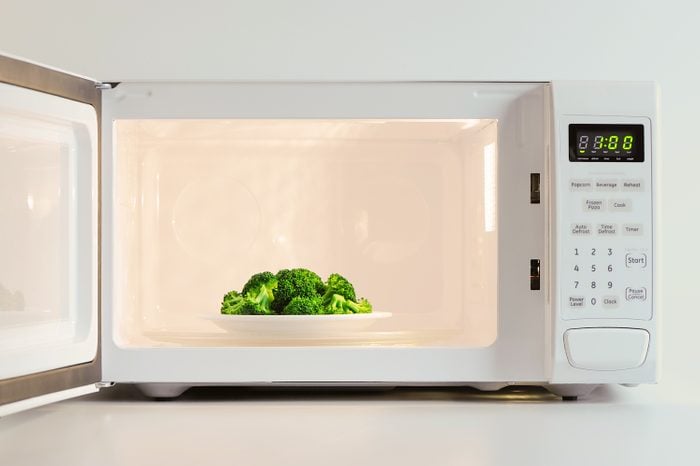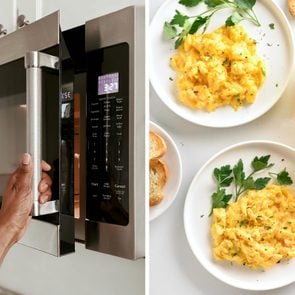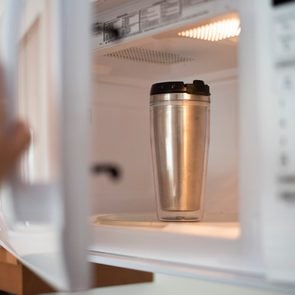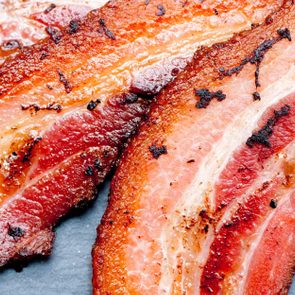If You’re Not Using This Microwave Button, You Need to Start
Updated: Apr. 13, 2024

This little button is the secret to achieving the perfect cook, texture and flavor from your microwave every time
When it was invented, the microwave was a total game changer in the kitchen. Yet over time, scores of home cooks have delegated the appliance to reheating duties alone, when it has the potential to be so much more.
One reason people are hesitant to use the microwave to its fullest is that they aren’t fully comfortable with all the features—and at the top of this list is the power-level button (though the popcorn button gets an honorable mention). “Think of adjusting your microwave’s power level similarly to adjusting the heat on your stove or your oven,” says Steph Chen, CEO and founder of the microwave cookware company Anyday. “You wouldn’t cook everything under your broiler or on high heat on your stove. The same thing goes for the microwave.”
Here, find out how to make the most out of the power-level button on your microwave and avoid the most common microwave mistakes.
Get Reader’s Digest’s Read Up newsletter for more food tips, humor, cleaning, travel, tech and fun facts all week long.
What is the power-level button?
Just like the knobs on your stove allow you to adjust the heat beneath your pots and pans, the power-level button adjusts the temperature at which food cooks in your microwave.
“All microwaves default to cooking at full power [level 10]. However, the power-level button enables you to cook certain foods more gently,” explains Chen. “For most standard microwaves, the power-level function actually pauses the microwaves for short periods of time to allow the food to cook at a slower rate. You can even hear the microwave’s magnetron switch on and off if you listen closely.”
Here’s how this works: “During this ‘off’ period, the residual heat that’s generated in your food from the full-power cooking continues cooking your food without the more intense direct microwave heat,” says Chen. “This means that when you set your microwave to power level five, or 50% power, there are waves bouncing around inside only 50% of the time, allowing the food to cook more gently.”
She adds that microwaves that use inverter technology are the exception to this rule.
Why should you bother with the power-level button?
Most people think of food that’s cooked in the microwave all coming out the same. But if you use the power-level button, that won’t be the case. “The primary benefit of cooking on low power is that food is cooked more gently, often resulting in better textures, and cook times are more forgiving,” Chen says. “It’s harder to overcook!”
That’s a boon, whether you’re whipping up a fast batch of microwaved poached eggs, a bowl of oatmeal or a sweet cup of hot cocoa.
Using the power-level button also cuts down on bubbled-over food, making cleaning your microwave easier. “Certain foods, like grains and eggs, need a gentler heat to achieve the texture you want and avoid overflowing or burning,” adds Chen.
How do you use the power-level button?
Instead of selecting a specific temperature or a heat range, such as low, medium or high, adjusting the power level on a microwave is usually a matter of selecting a numerical power level from 1 to 10 or a percentage of full power, such as 50%.
All microwaves are slightly different, so your best bet is to check your manual to figure out how to adjust the power level.
What foods should you cook on low?
Power level: 1 to 4 or 10% to 40%
Your microwave’s lowest power levels are best for defrosting frozen foods, says Chen. “Though microwaves work by vibrating molecules like water to generate heat, the appliance can only do that if water is in liquid form,” she explains. “When you take frozen food out of the freezer, the outermost layer of water immediately begins to thaw. The microwave can penetrate that thin layer of water, heating it up. That heat generated from the thin layer of liquid water then heats up the next layer of ice.”
Using a lower power level actually helps this process happen faster and more efficiently. “If the microwave is at full power, it will evaporate too much of that water layer for it to efficiently penetrate the ice,” she adds.
You can also use the lowest power levels to soften butter, cheese and ice cream without melting them and warm up bread and other baked goods without overheating or burning them.
What foods should you cook on medium?
Power level: 5 to 9 or 50% to 90%
Many foods will cook more evenly and with a better texture if you use a medium power level. That includes:
- Grains: “Grains like rice and quinoa are best when they are gently steamed, which is why they need to be cooked at a lower power level,” Chen says. “Starchy grains may also bubble over and burn at full power in the microwave, which creates a total mess and results in inedible food.”
- Dairy-based foods: “Just like on the stove, dairy should be heated up gently if cooking for a longer period of time to avoid separating or burning,” says Chen. “For instance, cheesecake is cooked at power level 4 to maintain its shiny, silky texture and not scorch the cheese and cream.”
- Animal proteins: “If you have a meat or protein that easily dries out, use a lower power level to cook it in the microwave. The lower the power level, the more gentle the heat, so the meat comes out tender and juicy. Try this with fish and chicken, which both come out stunningly well at lower power,” she says. “This can both help develop better textures and expedite the cook time versus cooking on the stove.”
What foods should you cook on high?
Power level: 10 or 100%
It’s possible to cook pretty much any food at full power in the microwave, but you may not get the best possible results. “They will probably come out pretty well if you’re cooking with a tight-fitting lid,” Chen says. “It’s just that cooking at lower power will sometimes make for the very best textures and flavors.”
If you’re heating up convenience foods or leftovers, those with a high water content, such as soups and vegetables, are going to heat best in the microwave in general—dry foods will only get drier.
Of course, before you toss those leftovers in the microwave at any power level, you’ll need to know how long leftovers last in the fridge and what to do with leftover rice to avoid food poisoning.
About the experts
- Steph Chen is the CEO and founder of Anyday, a company that makes glass cookware designed to be used in your microwave.



